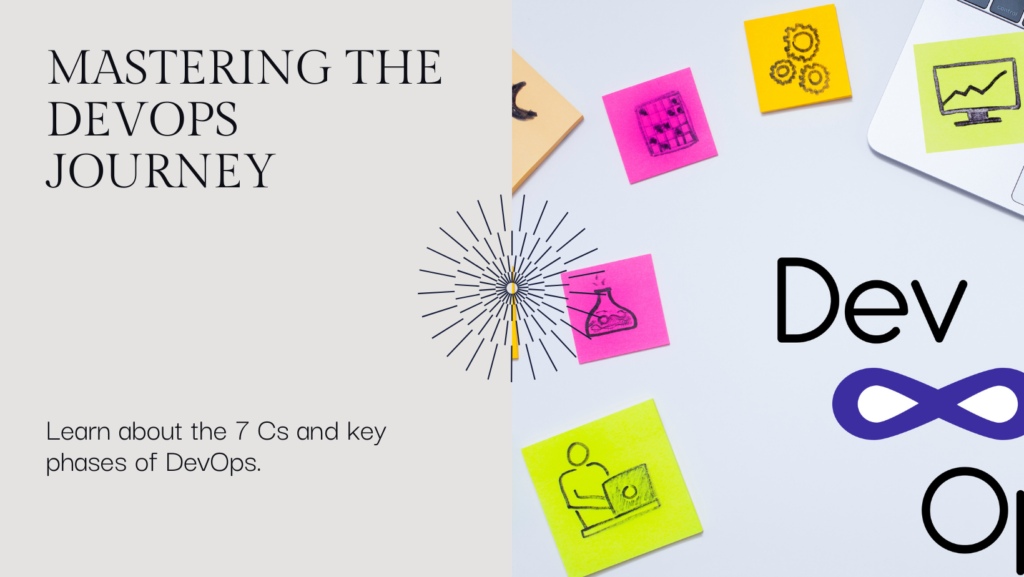The DevOps Lifecycle: Key Phases and the 7 Cs

Introduction:
DevOps, a fusion of “Development” and “Operations,” is a transformative approach to software development and IT operations that has revolutionized the way organizations deliver software. At its core, DevOps is about collaboration, automation, and a commitment to delivering high-quality software faster. In this blog post, we will explore the DevOps lifecycle, its key phases, and the 7 Cs that are essential for successful DevOps implementation.
What is the DevOps Lifecycle?
The DevOps lifecycle represents a series of stages that software development and IT operations teams go through to deliver software efficiently. It encompasses the entire application lifecycle, from planning and coding to testing, deployment, and monitoring. The DevOps lifecycle is characterized by continuous integration, continuous delivery (CI/CD), and continuous monitoring. Let’s delve into the key phases of the DevOps lifecycle.
Key Phases of the DevOps Lifecycle:
- Plan: The planning phase involves defining the project scope, setting goals, and creating a roadmap. It is where development and operations teams collaborate to align on objectives and priorities.
- Code: In the coding phase, developers write and test the code for the software. This is where version control systems like Git come into play, ensuring code changes are tracked and managed.
- Build: During the build phase, code is compiled, and dependencies are resolved to create deployable artifacts. This phase often employs automation to streamline the process.
- Test: The testing phase involves automated and manual testing to ensure that the software functions correctly and meets quality standards. Automated testing is crucial for quick feedback.
- Release: In the release phase, the software is deployed to the target environment. CI/CD pipelines automate this process, allowing for continuous and reliable deployments.
- Deploy: The deployment phase involves configuring the application and infrastructure for production use. Automation and infrastructure as code (IaC) play a significant role here.
- Operate and Monitor: After deployment, the software is continuously monitored to ensure it operates smoothly. This phase includes performance monitoring, error tracking, and user feedback.
The 7 Cs of DevOps:
The success of DevOps relies on the 7 Cs, a set of core principles:
- Collaboration: Encourage cross-functional collaboration between development and operations teams. Silos hinder progress; collaboration fosters shared goals and knowledge.
- Communication: Effective communication is key to a DevOps culture. Clear, open lines of communication ensure everyone is on the same page, reducing misunderstandings and errors.
- Culture: Cultivate a DevOps culture that values automation, continuous improvement, and a blame-free approach to failures. A strong culture supports DevOps practices.
- Automation: Automate repetitive, error-prone tasks in the software development and deployment processes. Automation reduces human errors and accelerates delivery.
- Continuous Integration (CI): Implement CI to merge code changes frequently and automatically test them. This ensures that new code doesn’t disrupt the existing application.
- Continuous Delivery (CD): Extend CI with CD to automatically deploy code changes to production, making software delivery rapid, reliable, and repeatable.
- Continuous Monitoring: Continuously monitor the application’s performance and user feedback. Real-time data allows quick responses to issues and performance bottlenecks.
Conclusion:
The DevOps lifecycle and the 7 Cs are the cornerstones of successful DevOps practices. By adopting this approach, organizations can achieve faster and more reliable software delivery, enhanced collaboration between teams, and a culture of continuous improvement. DevOps isn’t just about tools and automation; it’s a mindset and methodology that can revolutionize the way software is developed and delivered in today’s fast-paced, technology-driven world. Embrace DevOps, and you’ll be well on your way to achieving operational excellence.

Leave a Reply